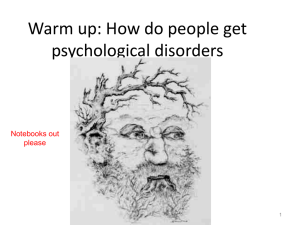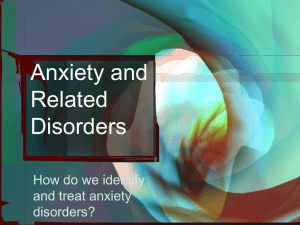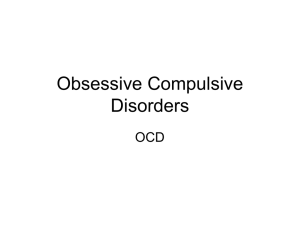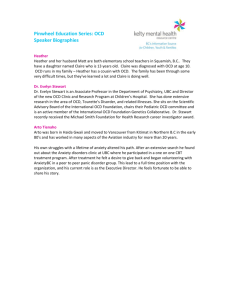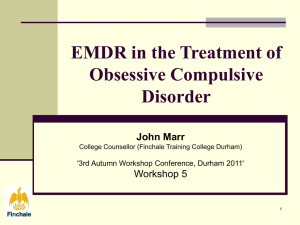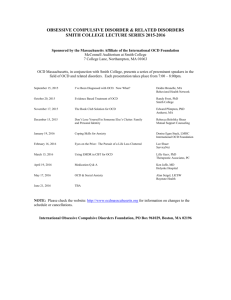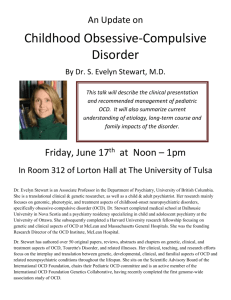Abnormal Psychology
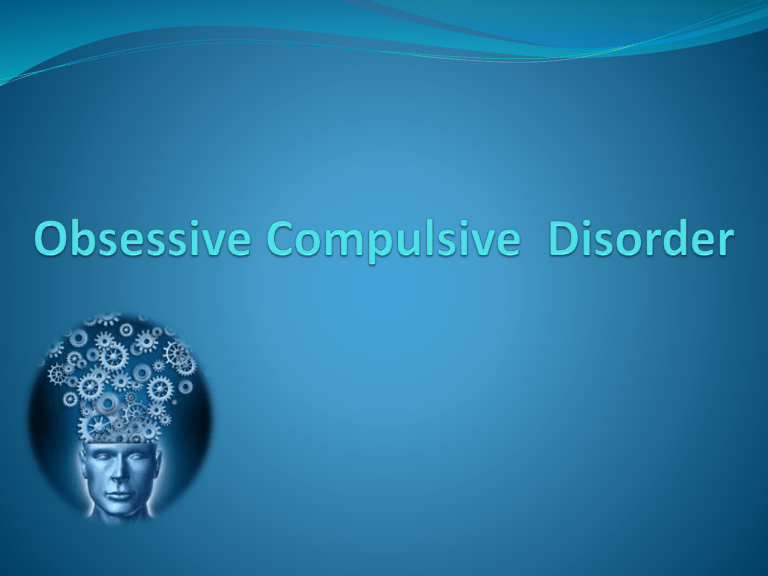
I. AICE Syllabus
A.
1.
2.
3.
Definitions, measures and examples
Define obsession/compulsion
Case study
Measuring OCD
B.
1.
2.
3.
Explanations
Psychoanalytic
Biomedical cognitive
C.
1.
2.
3.
4.
5.
Treating OCD
Systematic Desensitization
Flooding
Applied tension
CBT
Biomedical
II. Definitions, measures & examples
A.
1.
Definitions of key terms a.
b.
c.
d.
Obsession = a recurring and persistent thought that interferes with normal behavior
Fear of germs, contamination, etc.
Fear of harm coming to self or loved ones as a result of one’s own actions (e.g. if I forget to turn off the stove the house will burn down and my family will die.)
Other common themes include religious obsessions, sexual obsessions and a need for symmetry
This was found to be true in a cross-cultural sample study by Gibbs in 1996
2.
f.
a.
b.
c.
d.
e.
Compulsions = a recurring action a person is forced to enact
Washing hands repeatedly
Checking (locks, the stove etc..) repeatedly
Doubting – an action was completed and being forced to re-do it.
Touching repeatedly. Must touch objects that one passes by.
Ordering and organizing – must put things in order or sequence
Repeating words
3.
a.
b.
c.
d.
DSM 5 Criteria
Presence of Obsessions or compulsions or both
Obsessions are defined by recurrent and persistent thoughts, urges or images that are experienced as intrusive and unwanted.
The individual attempts to ignore or suppress the thoughts with other thoughts or actions
Compulsions are defined by repetitive behaviors that the individual feels driven to perform. These behaviors are aimed at preventing or reducing anxiety or distress
The obsessions and compulsions are time consuming, taking more than 1 hour daily
B.
1.
Case Studies a.
b.
c.
d.
The Boy who couldn’t stop washing
Charles began to wash obsessively at age 12, often taking 3 hours to shower and 2 hours to dress afterwards
Missed school due to lengthy showers
Complained of having a “sticky” substance on his hands that he couldn’t get rid of.
His mother supported this by giving in to his compulsions and scrubbing the house with rubbing alcohol and keeping guests out.
e.
f.
Drug therapy with Anafranil
(clomipramine) was effective for about year prior to the client developing tolerance
Has adjusted to live with the symptoms
2.
a.
b.
c.
d.
e.
Case of Mary – religious obsession
A 68 y/o housewife referred by her family and priest
Hadn’t left house in 5 years, hand were bleeding from excessive washing (6-8 hrs daily).
Problems had caused significant problems for family
Preformed excessive religious rituals
Was worried that the “Host” was on everything her children and husband touched and she was too impure to touch it herself. So she began to wash her hands excessively and clean all the furniture excessively.
f.
g.
h.
i.
Treated with a SSRI to treat both her depression and her OCD
Also treated with Exposure therapy and behavioral contracting
Forced to hold the communion wafer with her hands
Contracting to limit her behavior. Wash hands only 10x daily at first then only 5x daily
3.
a.
b.
Case Study – Sarah
Victim of a sexual assault
Years latter her reactions include rituals that she would have to perform to leave her house
c.
d.
e.
All appliances had to be unplugged and each one had to be rechecked multiple times resulting in a 2 hour delay in leaving for work.
Worries that she may have been in an accident while driving and hurt someone accidently resulting in her driving back to check.
Exposure and response prevention therapy – force the client to leave lights on and appliances plugged in while limiting checking behaviors.
C.
Measuring OCD
1.
a.
b.
c.
Y-BOCS = The Yale-Brown Obsessive
Compulsive Scale.
One of the most reliable and valid instruments for screening for OCD
10 items on a 4 point scale
0-7 = subclinical while 32 – 40 = extreme
2.
a.
b.
c.
OCI = Obsessive Compulsive
Inventory (OCI-R revised)
42 item 0-4 likert score
7 sub scores for different types of behaviors
Scales include (washing, checking, doubting, ordering, obsessions, hoarding, neutralizing
3.
a.
b.
VOCI = Vancouver Obsessional compulsive Inventory another validated measure of OCD.
55 items on a scale of 0-4.
Creates 6 subscales – Checking, obsessions, hoarding, perfectionism, indecisiveness.
4.
a.
b.
MOCI – Maudsley Obsessive-
Compulsive Inventory
A forced choice yes/no test with 30 questions
4 subscales, checking, cleaning/washing, slowness, doubting.
4. Validity and Reliability of Measures
a. Goodman et al.
Studied the reliability of the YBOCS
Examined 40 patients with OCD
Cornbach’s α = a measure of reliability showed high internal consistency meaning it was reliable
Found that it is a reliable instrument for measuring the severity of the illness b. Kim et al.
Compared the YBOCS the SC-90 (Symptom Checklist 90) and the
NIMH-GOCS (National Institute of Mental Health – Global
Obsessive Compulsive Scale)
23 patients
Found the YBOCS and NIMH-GOCS to be reliable but the SC-90 was not.
c. Sternberger and Burns
Examined 22 total individuals with 11 scoring in the highest level of the MOCI and 11 scoring in the normal range.
This study found that the MOCI was a valid instrument for rating OCD
A.
III. Explanations of OCD
Biomedical
1.
a.
b.
c.
Genetic Influences
Meta-analysis done by Billet, Richter & Kennedy 1998 looked at
109 twins (80 identical and 29 fraternal) found moderate concordance rates for identical 54/80 whereas only 9/29 in fraternal
Hoaker and Schnurr found concordance rate of 50-60% in twins
Pedigree studies done by Carey and Gottesman in 1981 also indicated about a 10% concordance rate (higher than probability) for having a 1 st degree relative also with the Dx
2. Murphy et al 2003 identified the hSert gene as a key component in OCD
a. They studied 112 unrelated individuals with OCD and
271 patients with other disorders or no disorders b. Identified a gene responsible for the transport of serotonin (hSERT) which increases the reuptake of serotonin and thus decreases the amount of serotonin available. Furthermore they noted a second mutation on 5-HTTLPR has the same effect compounding the negative effect on serotonin
2.
a.
b.
c.
d.
The role of Serotonin
During the 1960’s it was discovered that the tricyclic Anafranil was effective in reducing the symptoms of OCD
Anafranil was found to be more effective than other tricyclics using double-blind placebo studies.
This effectiveness was believed due to the drug’s influence on serotonin
Further research on newer SSRI’s which directly target serotonin are even more effective
3.
a.
b.
c.
Abnormalities in Brain Functioning
No studies have revealed consistent issues with structure HOWEVER, studies have shown a difference in functioning
PET Scans show that clients with OCD have abnormally active metabolic levels in the orbital prefrontal cortex and caudate nucleus (Brody & Baxter 1996)
One theory ties the striatum a subcortical portion of the brain tied to behavioral responses to stimuli. People with problems in this area can’t control impulses to check or intrusive thoughts
B.
Behavioral explanations
1.
a.
b.
c.
d.
Mowrer’s Two-process avoidance learning theory
The first part is based on classical conditioning whereby a neutral stimulus such as shaking hands becomes associated with a threatening thought such as contamination.
The second process involves operant conditioning whereby the individual discovers that the anxiety is relieved by a particular action such as hand washing.
When the anxiety leaves the hand washing is reinforced
(negative reinforcement)
This becomes the basis of exposure therapy.
2. Rachman and Hodgson supported Mower’s theory when they found that when OCD patients were exposed to a situation triggering their obsession they did experience anxiety. They also found when they performed the ritual
(compulsion) the anxiety was reduced. (see text book for full description)
3. Evaluation
a. Face Validity – this theory makes sense as we can see how a compulsion – washing hands, will reduce anxiety b. Scientific support for exposure therapy (see next section) strongly supports this theory. (see text book for studies) c. Tends to be reductionist in that the behavioral approach does not account for thoughts therefore it can’t explain obsessions. It also does not account for genetics or evolutionary predispostions
d. On your own think about how this explanation is more nature or nurture.
e. On your own think about if this explanation is deterministic
C. Cognitive explanations of OCD
1. Believe that everyone has negative intrusive thoughts.
What is different about OCD patients is that they blame themselves for these thoughts and expect bad things to happen
2. To avoid these negative outcomes they must take action (compulsions) to neutralize these thoughts.
3. Salkovskis 2003 found that compulsions are based on cognitive errors. He takes a partial behavioral approach when he considers the role of the compulsions in reducing anxiety but further explains that these reductions in anxiety never let the person check for the fallacy of their negative cognitions.
a. If you will recall in phobias, when the person learned that their anxiety had limits they were able to face their fears.
b. Here the person does the compulsion so they never learn that their obsessions are unfounded.
4. Neziroglu et al. found that 39% of female patients with obsessive compulsive disorder with children reported an onset of the disorder during pregnancy.
5. Abramowitz’s review of the faulty cognitions shown by obsessive compulsives also supports the exaggerated sense of personal responsibility explanation because such cognitive errors include the belief that thoughts can help to cause events (called thought–action fusion), e.g. “If I wish someone dead, that increases the chances they will die”; and the belief that mistakes and imperfection are intolerable and so they have a responsibility to be perfect, e.g. “I must ensure that I always do the right thing”.
6. Evaluations
a. Research into cognitive factors relies on self-report, e.g. the research whereby patients reported their symptoms developing during pregnancy. Such report is retrospective and so may not be accurately recalled. Furthermore, the self-report method yields subjective data as it is vulnerable to bias and distortion as a consequence of researcher effects and participant reactivity, e.g. patients may prefer to accept pregnancy as an explanation over other possible origins. Thus, the findings may be biased, and therefore not true, and so have limited validity. b. Does not explain the causes The research describes the nature of the thoughts of OCD patients rather than explaining the development of OCD because it is not clear what causes the negative cognitions in the first place, other than that some are triggered by pregnancy, but this is not true of all cases.
D.
1.
Psychodynamic
Freud would state that the subject is fixated in the anal stage of development
2.
a.
b.
c.
OCD is seen as ego defense mechanisms gone to the extreme
Isolation – related to the obsessions – seen as unwanted foreign intrusions
Undoing – cancel out something disturbing by doing something else – washing hands undoes bad thoughts
Reaction formation – Acting the opposite allows you to suppress unwanted feelings by acting the opposite way.
3.
a.
b.
Evaluation of this approach
Reductionist – essentially Freud breaks OCD down to a problem with potty training and over-active defense mechanisms
Unscientific – as the construct is nearly impossible to test, but studies by Gross in 1996 found no relation to “strict” potty training and the later development of OCD
IV. Treating OCD
A. Drug Therapy
1.
As mentioned previously treatment with SSRI’s and
Anafranil have been shown to be efficacious
2.
a.
b.
c.
d.
Selvi et al 2011
Initially study 90 patients on SSRI’s alone who showed no improvement in symptomology
Took 41 of these patients and randomly assigned them to take either risperidone and aripiprazole in addition to the SSRI’s for 8 weeks.
Measured success by at least a 35% decrease in Y-BOCS score.
Aripiprazole group had at least 50% of the group showing a
35% decrease and the risperidone group had a 72.2% decrease
3.
a) b) c)
Another study by Askari et al 2012 did similar research using granisetron in conjunction with fluvoxamine (an
SSRI known as Luvox).
Also used a 35 % decrease in Y-BOCS score as a measure
100% had achieved this by 8 weeks and 90% had achieved complete remission as evidenced by a score of 16 or less on the Y-BOCS
Only 35% of those in the placebo condition had achieved the same response
B. Cognitive therapy – same as previous cases in that you identify faulty thinking patterns involved in problem behavior.
1. Focus on how patients interpret their obsession including why they have it and what will happen if they don’t find some way to relieve it.
2. Ask the person to challenge the thoughts in the same way we did with phobias. See if the anxiety will kill you.
3. Patients fill out thought record (see example in class)
a. Where was I/what was I doing when the obsession began b. What intrusive thought or ideas did I have c. What meaning did I apply to the obsession d. What did I do about the obsession
An Example of a Thought Record Situation:
Sitting at home watching television.
Intrusive Thought: "God doesn't care."
Appraisal of Intrusive Thought:
1. I am a bad person for thinking blasphemous thoughts.
2. God will punish my family and me.
3. I must be losing my mind if I can't stop these thoughts from happening.
Ritual: Engage in prayer.
Engage in behaviours of atonement.
4. After people learn to identify their intrusive thoughts and the meanings they apply to them, the next steps are:
a. Examine the evidence that supports and does not support the obsession.
b. Identify cognitive distortions in the appraisals of the obsession.
c. Begin to develop a less threatening and alternative response to the intrusive thought/image/idea.
5. Most often this will be combined with behavioral therapy especially Exposure and Response Prevention
(ERP – see next section)
C. Behavioral Therapy – Exposure and Response
Prevention
1. Similar to flooding in Phobias in that patient is exposed directly to his/her anxiety causing stimuli. For example must use the toilet without washing hands
2. Begins with creating a hierarchy similar to that in phobias.
3. Works on the behavioral concept of habituation. Once you are exposed and prevented from responding you will be come used to (habituated to) the anxiety and it will then diminish.
4. Starts with the most mild item in the hierarchy and them moves to more difficult items
D. Support for CBT
1. Bolton et al 2011 examined brief CBT, full CBT and a wait-list condition for 96 children with OCD. Both CBT groups showed a significant decline in Y-BOCS score showing that brief CBT is not only effective but cost effective as well.
2. Olatunji et al 2013 compared behavioral therapy (BT) to
CBT with 62 adults with an OCD Dx. Again the Y-BOCS was the DV and the BT was found to be superior to CBT
E. Psychoanalytic Therapy
1.
2.
a.
b.
c.
Techniques
Free association
Dream Analysis
Hypnosis
Chlebowski & Gregory 2009 found that psychoanalytic therapy with late onset patients was effective.
3.
Leichsenring et al 2008 found that long term psychoanalysis was associated with significant reduction in the OCD symptoms
